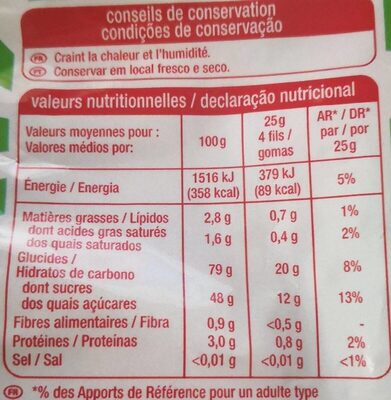Fils - Auchan - 0.2 kg
This product page is not complete. You can help to complete it by editing it and adding more data from the photos we have, or by taking more photos using the app for Android or iPhone/iPad. Thank you!
×
Some of the data for this product has been provided directly by the manufacturer AUCHAN APAW.
Barcode: 3596710459230 (EAN / EAN-13)
Common name: Bonbons gélifiés aromatisés goûts Tutti Frutti, Pomme, Framboise, Fraise
Quantity: 0.2 kg
Brands: Auchan
Categories: Snacks, Sweet snacks, Confectioneries, Candies
Labels, certifications, awards: No colorings, Nutriscore, Nutriscore Grade D
Stores: Auchan
Matching with your preferences
Environment
Carbon footprint
Packaging
Transportation
Threatened species
Report a problem
Data sources
The manufacturer AUCHAN APAW uses Agena3000 to automatically transmit data and photos for its products.
Product added on by kiliweb
Last edit of product page on by org-auchan-apaw.
Product page also edited by inf, manu1400, ocr-nutriscore, openfoodfacts-contributors, roboto-app, teolemon, yuka.Mq4ZZ93XEtw9QPPt0YtvwymGBOLQWdZBPFQOoQ, yuka.VGE4N0M0bFltS1lUcE5nUDBSbjQ4OVYyMWJ5dFFrL3NlOU0ySVE9PQ, yuka.sY2b0xO6T85zoF3NwEKvlhBafv7CrRbJNTzglxG6ntC-cbHzQehfvbqqHqo.











